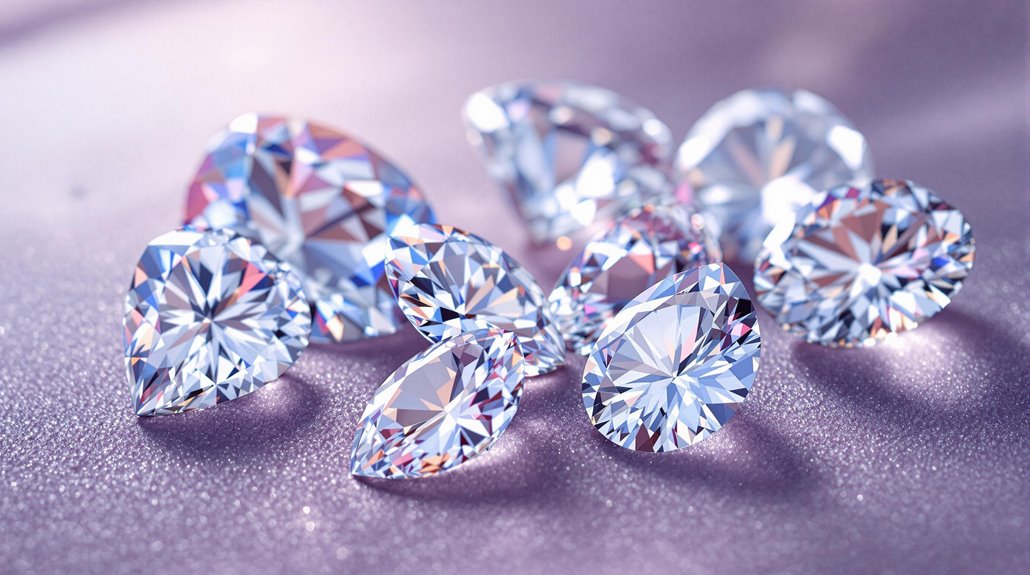Article Contents
- 1 Main Highlights
- 2 Frequently Asked Questions
- 2.1 How Does Diamond Shape Affect the Overall Value of the Stone?
- 2.2 Can Certain Diamond Shapes Appear Larger Than Others of Equal Carat Weight?
- 2.3 Which Diamond Shapes Are Most Resistant to Chipping and Damage?
- 2.4 Do Some Diamond Shapes Require More Frequent Cleaning Than Others?
- 2.5 How Do Different Diamond Shapes Perform Under Various Lighting Conditions?
Although the round brilliant cut dominates the diamond market, sophisticated buyers are discovering compelling substitutes that offer unique aesthetic appeal and value. From the elongated elegance of oval and marquise cuts to the vintage allure of cushion and emerald shapes, each choice presents distinct characteristics in terms of fire, brilliance, and visual impact. Modern diamond selection embraces both technical superiority and personal style, with various shapes providing different advantages in size appearance and cost efficiency. The expedition through diamond shapes reveals endless possibilities for the discerning collector.
Main Highlights
- Elongated shapes like oval and pear create an illusion of larger size while offering unique aesthetics and optimal light performance.
- Cushion and emerald cuts provide vintage appeal with distinct faceting patterns that showcase different diamond characteristics.
- Princess cuts maximize fire and brilliance through 70+ facets, offering a modern square alternative to round brilliants.
- Length-to-width ratios and optical effects significantly impact a diamond's appearance and should guide shape selection.
- Alternative shapes can offer better value, with emerald cuts being more affordable due to minimal rough diamond waste.
Though the allure of diamonds has captivated humanity for centuries, comprehending the intricacies of diamond shapes remains vital for both collectors and enthusiasts searching for the perfect stone. Recent diamond shape trends reveal that whereas the round brilliant cut dominates the market, accounting for approximately 75% of engagement ring selections, substitute shapes are gaining remarkable momentum among discerning buyers. This diamond shape comparison demonstrates how each variation offers unique characteristics that cater to different aesthetic preferences and practical considerations.
Beyond the classic round brilliant, contemporary collectors often gravitate toward elongated shapes such as oval, pear, and marquise cuts, which create an illusion of greater size during the maintenance of exceptional brilliance. These sophisticated choices have become particularly appealing to those aiming to make a distinctive statement as they maximize their investment. The oval shape, for instance, combines the fire of a round brilliant with an elongated silhouette that flatters the wearer's hand. Brilliant cut diamonds feature 58 perfectly positioned facets to maximize light reflection and sparkle. The heart cut diamond requires exceptional skill to create and stands as one of the most challenging shapes to execute properly. The step cut design creates a mesmerizing hall of mirrors effect with its rectangular facets. A refractive index measurement helps determine how effectively each shape interacts with light to produce brilliance.
The distinction between a diamond's cut and shape proves fundamental for informed selection. While shape determines the stone's external appearance, cut quality influences its light performance through precise angles and facets. This interplay of characteristics becomes evident in shapes like the princess cut, which features over 70 facets designed to maximize fire and scintillation, even with its squared outline. The Four Cs serve as the foundation for evaluating any diamond's overall quality and value.
For those attracted to vintage aesthetics, the cushion cut offers a romantic appeal with its softened corners and brilliant faceting pattern. The emerald cut, with its step-cut facets, showcases exceptional clarity while providing a more affordable choice because of minimal waste during the cutting process. These selections exemplify how different shapes can align with both personal style and practical considerations.
The evaluation of diamond shapes extends beyond mere aesthetics to include technical aspects such as length-to-width ratios and the potential presence of optical effects like the bowtie pattern in elongated cuts. Professional gemologists assess these characteristics alongside traditional measures of cut quality, including brightness, fire, and scintillation, to determine a stone's overall value and appeal.
Substitute shapes, including octagonal cuts and complementary stones like trapezoids and baguettes, provide additional selections for those desiring truly unique pieces. These less common choices often appeal to connoisseurs who appreciate both the artistic and technical aspects of diamond cutting. Each shape tells its own story through the way it captures and releases light, creating a distinctive personality that resonates with its eventual owner.
Frequently Asked Questions
How Does Diamond Shape Affect the Overall Value of the Stone?
Diamond shape significantly influences value through market demand, cut quality, and rarity impact. Round brilliants command premium prices because of widespread appeal, whereas fancy shapes fluctuate based on current trends.
Can Certain Diamond Shapes Appear Larger Than Others of Equal Carat Weight?
As carat weight remains constant, shape perception creates fascinating size illusions. Marquise, oval, and pear cuts masterfully play with surface area, appearing larger through clever carat illusion.
Which Diamond Shapes Are Most Resistant to Chipping and Damage?
Round and oval diamonds resist chipping best, followed by emerald-cut for durability and cushion-cut for resilience. These shapes avoid vulnerable points that could break under everyday wear.
Do Some Diamond Shapes Require More Frequent Cleaning Than Others?
Like intricate snowflakes catching dust, complex diamond shapes with sharp corners and many facets demand more frequent cleaning than simpler designs. Shape maintenance varies significantly, with princess cuts requiring extra attention.
How Do Different Diamond Shapes Perform Under Various Lighting Conditions?
Round brilliants consistently demonstrate superior light reflection across lighting conditions, whereas fancy shapes display varied sparkle intensity. Each shape's performance depends on ambient lighting, with brighter environments revealing maximum brilliance.

